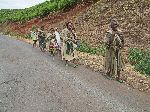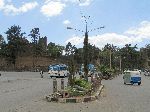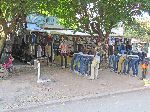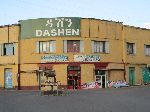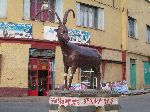| Ethiopia:
Abyssinia Adventure - Hwy 3 Bicycle Africa / Ibike Tours |
|||
 |
Lake Tana is visible to the west at several points of this sections but the road engineers determined that the most expeditious way to get from Adis Zemem to Gondar was not via the lake shore but on a direct route over several ridges. By the time you reach Gondar you are at the hills the foothills of the Simien mountains. | ||
 |
|||
| [Graphs are built with incomplete data and are only general representations of the topography.] | |||
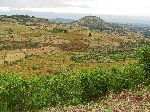 |
In contrast to the
topography of the previous section, this section has more than twice the vertical
difference -- more than 400m. While there were long sections between the ridges
that were relatively flat, there were sections on the
climbs that were over 12%. The redeeming value of the hills in Ethiopia -- and most other places -- is that they produce fantastic views. |
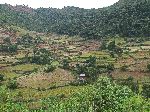 |
|
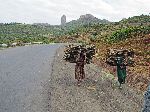 |
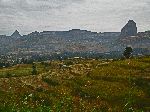 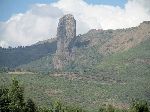 A
focus of the climb out of Adis Zemem is a lava plug called "God's tooth".
The gray, overcast morning doesn't do justice to any of the topography, but
even shrouded it dwarfed its surrounding and exhibited and exemplify the long
geological history of the area. A
focus of the climb out of Adis Zemem is a lava plug called "God's tooth".
The gray, overcast morning doesn't do justice to any of the topography, but
even shrouded it dwarfed its surrounding and exhibited and exemplify the long
geological history of the area.As we headed up the hill, groups of people were walking down, presumably heading for the market in Adis Zemen. Unhurried, some would stop for a chat, but we were near total failures at speaking Amharic so the conversations could only go as far as their English could take it. It was nice that they made the effort to accommodate us. |
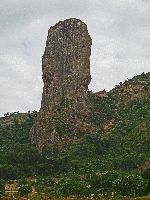 |
|
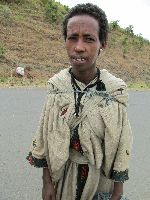
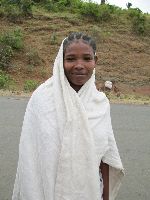

 |
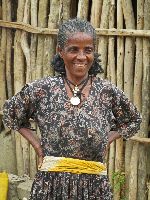 |
||
 |
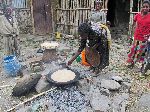 Morning
is when injera is cooked for the day. We stopped to visit and watch a group that was
cooking near the road. The activity seemed to be as much social as it was
productive. The half-dozen women gathered around talking represented several generations
--
only a couple of them were actively involved in cooking. Morning
is when injera is cooked for the day. We stopped to visit and watch a group that was
cooking near the road. The activity seemed to be as much social as it was
productive. The half-dozen women gathered around talking represented several generations
--
only a couple of them were actively involved in cooking. |
||
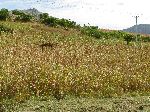 |
Again, the micro-climate changed as we descended and with that the vegetation
and economic activity. The grain at the bottom was sorghum (left).
Along with the agriculture there was animal husbandry and veterinarian services (right). |
 |
|
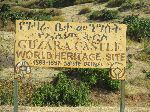 |
 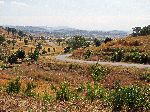 Guzara
Castle, (World Heritage Site) is five kilometers south of Infranze (Emfraz). It
has a commanding position on top of a hill that is accessed by a couple kilometers
of gravel road. Guzara
Castle, (World Heritage Site) is five kilometers south of Infranze (Emfraz). It
has a commanding position on top of a hill that is accessed by a couple kilometers
of gravel road.From the top there is a view that extends to Lake Tana in the distance. |
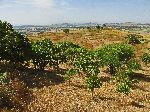 |
|
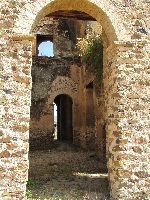 |
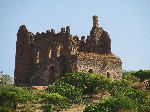
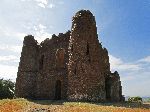

 The Castle's history is a little unclear. The most common recitation is that it was built around 1571-1572 for Emperor Sarste (Sarsa) Dengel (b. 1550 - d. 1597) (reign 1563-1597). Emperor Sarste Dengel was the founder of the Gonder dynasty, thus Guzara would represent the prototype of Gonderian design. Guzara’s architectural resemblance to the Gondarine castle has led recent expert speculation that it was built later. These hypothesis suggest Emperor Susneyos (b. 1572 - d. 1632) (reign 1606-1632) or his successor Emperor Fasilidas (b. 1603 - d. 1667) (reign 1632-1667). Fasilidas established Gondar as the Capital in 1636 and built the first structures in the Royal Enclosure, Fasil Ghebbi, a few years later. The guide at the site gave five reasons for the selection of this location for Guzara Castle:
|
||
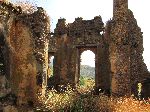

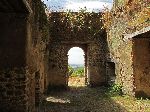
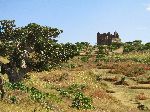
Now-a-days, Guzara Castle is only a shell of a building and perhaps most
intriguing as a photographic subject or backdrop for a photo shoot. |
|||
 |
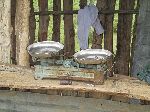 The river valley below the
castle is a khat growing area (also called chat, qat, qaad and other names). It
is endemic to arid areas of the Horn of Africa and Arabian peninsula, where khat chewing
is a social custom dating back thousands of years. Here, it is sold
at stalls that line a short section of roadway. I don't know the price, but it
is valuable enough that it is weigh with a scale. Typically it is transported,
with the leaf still on the branch, in plastic bags. The river valley below the
castle is a khat growing area (also called chat, qat, qaad and other names). It
is endemic to arid areas of the Horn of Africa and Arabian peninsula, where khat chewing
is a social custom dating back thousands of years. Here, it is sold
at stalls that line a short section of roadway. I don't know the price, but it
is valuable enough that it is weigh with a scale. Typically it is transported,
with the leaf still on the branch, in plastic bags.
Khat's appeal is it contains a monoamine alkaloid called cathinone, an amphetamine-like stimulant, which is said to cause excitement, loss of appetite and euphoria. People who are very high on it can act very stupid. |
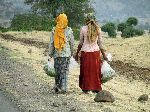 |
|
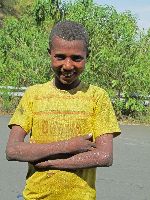 |
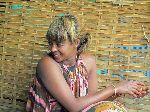  The
boys t-shirts says "Obama". He was very willing to be photographed in it. The
boys t-shirts says "Obama". He was very willing to be photographed in it.
In Infranza, we had coffee and tea in a shop were willing to be photographed. The young girl took a number of coquettish poses. It is a mystery where she learned them, but the top suspect is her very stylish mother. Out of Infranza the is another 200m climb and about equal descent, after which it is rolling without a lot of perceptible net elevation change. In fact, over the next 40km there is a net 300m of climbing. |
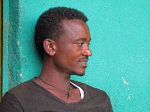 |
|
 |
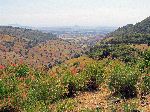
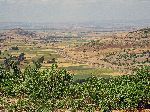
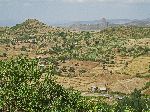
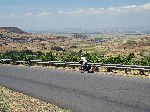 |
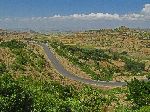 |
|
 |
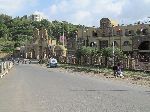 On
the outskirts of Gondar are a couple of landmark: The Dashen Brewery and the
University of Gondar. On
the outskirts of Gondar are a couple of landmark: The Dashen Brewery and the
University of Gondar. |
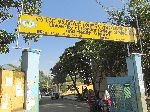 |
|
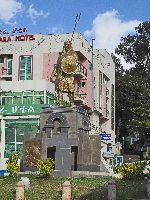 |
As you arrive in the
center of Gondar, you are greeted by a statue of Emperor Tewodros II (reigned
1855-1868). His rule came a century after the end of the "Gondar Dynasties" that
provide the town its distinction. Tewodros II is often placed as the beginning of modern Ethiopia.
He came to power in the Era of Princes, with many contentious, semi-autonomous
provinces, and helped bring it to an end. He labored to unify the country and resurrect the Solomonic Dynasty. In the process he was challenged by conflicts with
rebels and rivals, and encountered difficulties with the European powers, which
were, unsolicited, grabbing pieces of Africa to call their own.
Though he never realized his dream of restoring a strong monarchy, he took some important initial steps: He sought to establish the principle that governors and judges must be salaried appointees. He established a professional standing army, rather than depending on local lords to provide soldiers for his expeditions. He intended to reform the church, believing the clergy to be ignorant and immoral, but he was confronted by strong opposition when he tried to impose a tax on church lands to help finance government activities. His confiscation of these lands created enemies in the church and little support elsewhere. |
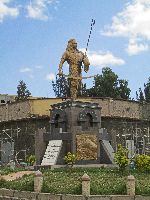 |
|
 |
The character of "Gondar" prior to 1636 is unknown, but in that year Emperor Falisadas, the son of Emperor Susenyos, established Gondar as his national capital. Prior to this, the Emperors and there large entourages tended to live in roving tent cities that taxed the local people for surplus food and cut down the forests. When the local resources were impoverished and exhausted they would move on. Gondar is built on a number of rounded hills with streets curving around them. Within the city numerous trees that enhance its beauty and livability. Perhaps this is the basis for the reference to Gondar as the "Camelot of Ethiopia". There are two
main reasons most
tourist are drawn to Gondar: to access trekking in the Semien Mountains, or to see
Fasil Ghebbi, the Royal Enclosure of Gondar. But beyond these draws, the town itself has a
pleasant ambience with sidewalk boutiques, cafes, quality restaurants, good
views, a variety of public buildings, and plenty of vegetation. |
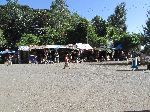 |
|
 |
There seems to have been an attempt to tie some of the architecture together by building stone-faced modern buildings that roughly replicate the look of the royal palaces at Fasil Ghebbi (left). At one point, a minor attraction in town was the Dashen beer building. The building is still there but the beer has moved on, so only half the former sign remains. The banner used to read "Dasen Beer". [Note: 2015, the sign is totally gone.] The wall of a cafe provokes a discussion with display of posters of great people (right). Left to right, top to bottom, they are: Emporer Tewodros II, Abe Lincoln, Nelson Mandela, Che Guevara, Alexander Graham Bell, Stephen Biko, (unidentified), Marcus Garvey, Malcolm X, Mahatma Ghandi, Martin Luther King Jr., Albert Einstein, (unidentified), Helen Keller, Beethoven, Mother Teresa, Marie Curie, John Kennedy, and Thomas Edison. I wonder if it is a collection that the cafe selected or a collection curated and sold by someone else. Who would be on your list? One of the cutest (as in Dr. Seuss
cute face) sights in town is the statue of an endemic Walia Ibex in a traffic circle
(right). It looks quite forlorn isolated in the urban environment. [Note: 2015,
it has been removed.] |
||
 |
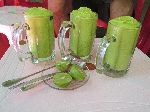 A
regular treat in the towns of northwest Ethiopia is the smoothie shop. I
don't know how long the season is, but we are fortunate to be visiting in
avocado season. Avocado trees have not been apparent along the roads, so I don't know if
the produce is local or trucked in. A
regular treat in the towns of northwest Ethiopia is the smoothie shop. I
don't know how long the season is, but we are fortunate to be visiting in
avocado season. Avocado trees have not been apparent along the roads, so I don't know if
the produce is local or trucked in.Typical of other Ethiopian towns, a lot of the
commerce is in small shops. This one offers an interesting mix of fresh
fruit and plastic ware (right) |
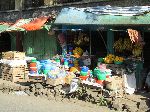 |
|
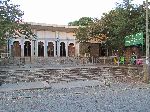 |
It was nice to see a
public library. Its stone walls and arches are architectural treatments
that clearly connected the building to the legacy of the royal enclosure. It
was closed at the time so there was no way to look inside. In the city, most
of the building had some element of non-traditional materials or construction,
but tucked into one plot was a tightly grouped cluster of traditional small, round
thatched-roof buildings (right). Most of the people in the area look like
students so conceivably this could be some kind of student housing. From the
edge it is hard to know what is happening here. |
 |
|
 |
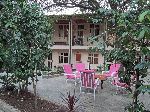
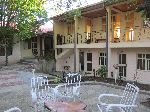 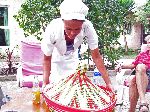 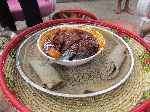 During our stay in Gondar, we resided at the Lodge Fasil. It is centrally located, beautifully landscaped, friendly, helpful, comfortable, and clean, and the manager arranged for us to have a lunch of Doro Wat (the national dish, common at weddings and celebrations, but not often served in small town and roadside restaurants). Though addictively delicious, it exceed the spice threshold for some northern pallets. |
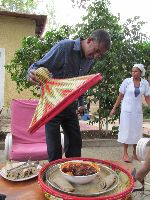 |
|
|
|
|||
|
|
Unique Programs To Special Places For Memories Of A Lifetime!
"Hosted by
DreamHost - earth friendly web hosting"
|
|
